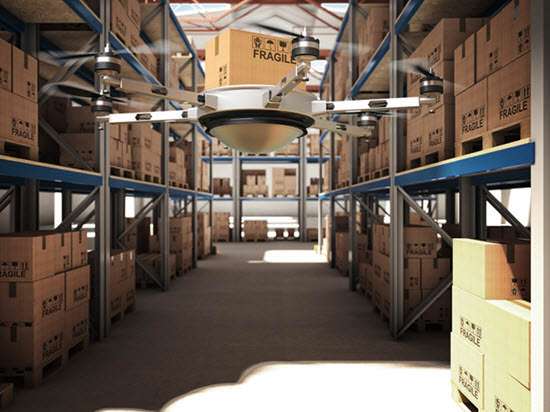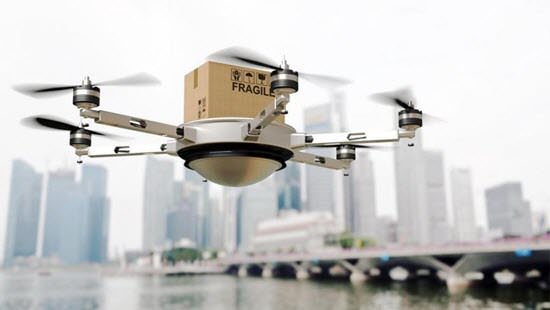In the recent past, unmanned aerial vehicles (UAVs) were most often associated with the military, where they were used initially for anti-aircraft target practice, intelligence gathering and then, more controversially, as weapons platforms.
Drones are now also used in a wide range of civilian roles ranging from search and rescue, surveillance, traffic monitoring, weather monitoring and firefighting to personal drones and business drone-based photography, as well as videography, agriculture and even delivery services.
A drone, in a technological context, is an unmanned aircraft. Drones are more formally known as unmanned aerial vehicles (UAVs) or unmanned aircraft systems (UASs). Essentially, a drone is a flying robot. The aircrafts may be remotely controlled or can fly autonomously through software-controlled flight plans in their embedded systems working in conjunction with on board sensors and GPS.

Table of Contents
Application of Drones
1. Inventory management
Drones can help warehouses update and coordinate their inventory management databases in several ways. Some heavy duty drones are able to help transport packages between warehouses to help meet local or even regional demand without relying on trucking. There are also developments in drone technology that include attaching barcode scanners to flying drones, allowing them to update inventory logs at a greater rate than human workers can and can even do so overnight.
2. Claims and returns
A customer dissatisfied with a product may no longer have to trek to the post office to return it, or require a truck to come by their home and add to the area’s traffic congestion drones will eventually be dispatched directly to the customer to pick up an unwanted item. Retailers could use heavier duty drones to return entire damaged pallets as well.
3. Store to customer
The long-term for drone use, as mentioned above, is using them to deliver directly to the customer. Perhaps the customer orders online, or perhaps they visit an in-store location and have their purchase delivered to them at home later that day. We already have the technology and logistics to facilitate same-day delivery, drones will only make that process easier and faster.
Drones in the Warehouse
Drones are seemingly been pulled from the pages of science fiction and made reality. Handy for a wide variety of applications, drones are set to make appearances in warehouses globally as firms seek to further increase levels of automation.

Drones can aid with tasks that could require a large number of man-hours. One such use is for barcode scanning, according to drone specialists Drone Scan. Warehouses are often stacked to the roof with inventory. This makes certain barcodes tricky to reach and could require the use of a forklift, cage and staff to scan them.
Benefits of Drones in Intra-Logistics Efficiency
Logistics industry have always held on to the most traditional ways of transporting goods which incorporate both extra workforce and cost. Further, it depends on various other factors which cause unwanted delays even when the user is ready to pay for same-day-delivery! Incorporating drones, in this case, would make the delivery service faster and more convenient without the use of workforce! If one were to keep aside the horde of legal formalities to launch drone deliveries and the different permission and licensing hassles the companies must go through, one could not overlook the benefits offered by these aerial devices.

UAVs could play a vital role in intra-logistics. Consider the automotive industry with its massive production sites, just-in-time processes, and mind-boggling cost of idle production lines: UAVs could support intra-plant transport as well as the supplier-to-plant emergency deliveries which are typically performed by helicopter today.
The full content is only visible to SIPMM members
Already a member? Please Login to continue reading.
References:
Bisht, S. (2017). “Drone Delivery, Evolution in the field of Logistics Industry”. Retrieved from https://www.shiprocket.in, accessed 31/08/2017/
DHL (2014). “Unmanned Aerial Vehicle in Logistics”. Retrieved from
http://www.dhl.com, accessed on 31/08/2017.
ITE Transport & Technology. (2016). “10 Warehousing Tech Innovations from around the World”. Retrieved from http://www.transport-exhibitions.com, accessed on 31/08/2017.
Rouse, M. (2016). “Drone – Unmanned Aerial Vehicle, UAV”. Retrieved from
http://internetofthingsagenda.techtarget.com, accessed 31/08/2017.
Schofield, J. (2016). “What Do Drones Mean for the future of Warehouses?”. Retrieved from http://www.systemid.com, accessed 31/08/2017.

